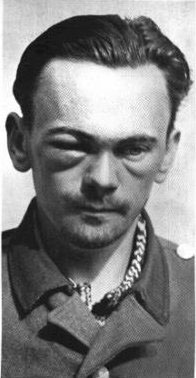Henry Rinnan
| Henry Oliver Rinnan | |
|---|---|

Rinnan photographed with visible bruises after his capture in 1945.
|
|
| Born |
14 May 1915 Levanger, Norway |
| Died | 1 February 1947 (aged 31) Trondheim, Norway |
| Allegiance |
|
| Years of service | 1940 –1945 |
| Rank | Untersturmführer/Gestapo agent |
| Unit | Gestapo 1940 – 1945 |
| Battles/wars | World War II |
Henry Oliver Rinnan (14 May 1915 – 1 February 1947) was a notorious Norwegian Gestapo agent in the area around Trondheim, Norway during World War II.
Rinnan led a group called Sonderabteilung Lola. This group, known as Rinnanbanden among Norwegians, had fifty known members. Among them were Karl Dolmen, Arild Hjulstad-Østby and Ivar and Kitty Grande.
Born in Levanger on 14 May 1915, Rinnan was the eldest of eight children in an impoverished family. Unusually short (1.61 metres – 5 ft 3 in), he was a loner during his childhood. He worked briefly for his uncle, but was sacked for theft.
During the Winter War, Rinnan tried to enlist with the Finns to fight against the Soviet Union, but was rejected due to his poor physique. During the Norwegian Campaign in 1940, he drove a truck for the Norwegian Army. According to Rinnan, he was recruited by the Gestapo in June 1940. His parents were members of Nasjonal Samling, but it is uncertain if he ever was a member. After the war, former members of Nasjonal Samling attempted to disassociate themselves from the group, which was seen as a pro-German unit.
Beginning in September 1943, the Rinnanbanden had its headquarters in Jonsvannsveien 46 in Trondheim, known as Bandeklosteret ("gang monastery"). Rinnan worked closely with the German Sicherheitspolizei in Trondheim, where his main contacts were Gerhard Flesch and Walter Gemmecke. During this decade the private residence of the Rinnan family was in the captured house of Landstads Vei 1, located approximately one kilometre from the gang's headquarters.
The members of the independent Gestapo unit Sonderabteilung Lola infiltrated the resistance movement by engaging people in conversation in buses, trains, cafés, etc., encouraging them to talk about their attitudes toward the Nazi occupation. Having identified people who they thought were in the resistance, Rinnan's agents worked to build trust with them and penetrate their networks. The Rinnan gang was responsible for the death of at least a hundred people in the Norwegian resistance and the British Special Operations Executive, for torturing hundreds of prisoners, for more than a thousand arrests, for compromising several hundred resistance groups, and in some cases, for deceiving people into carrying out missions for the Germans. Rinnan operated with impunity and little interference from his German taskmasters, often using murder and torture as sanctioned means.
...
Wikipedia
